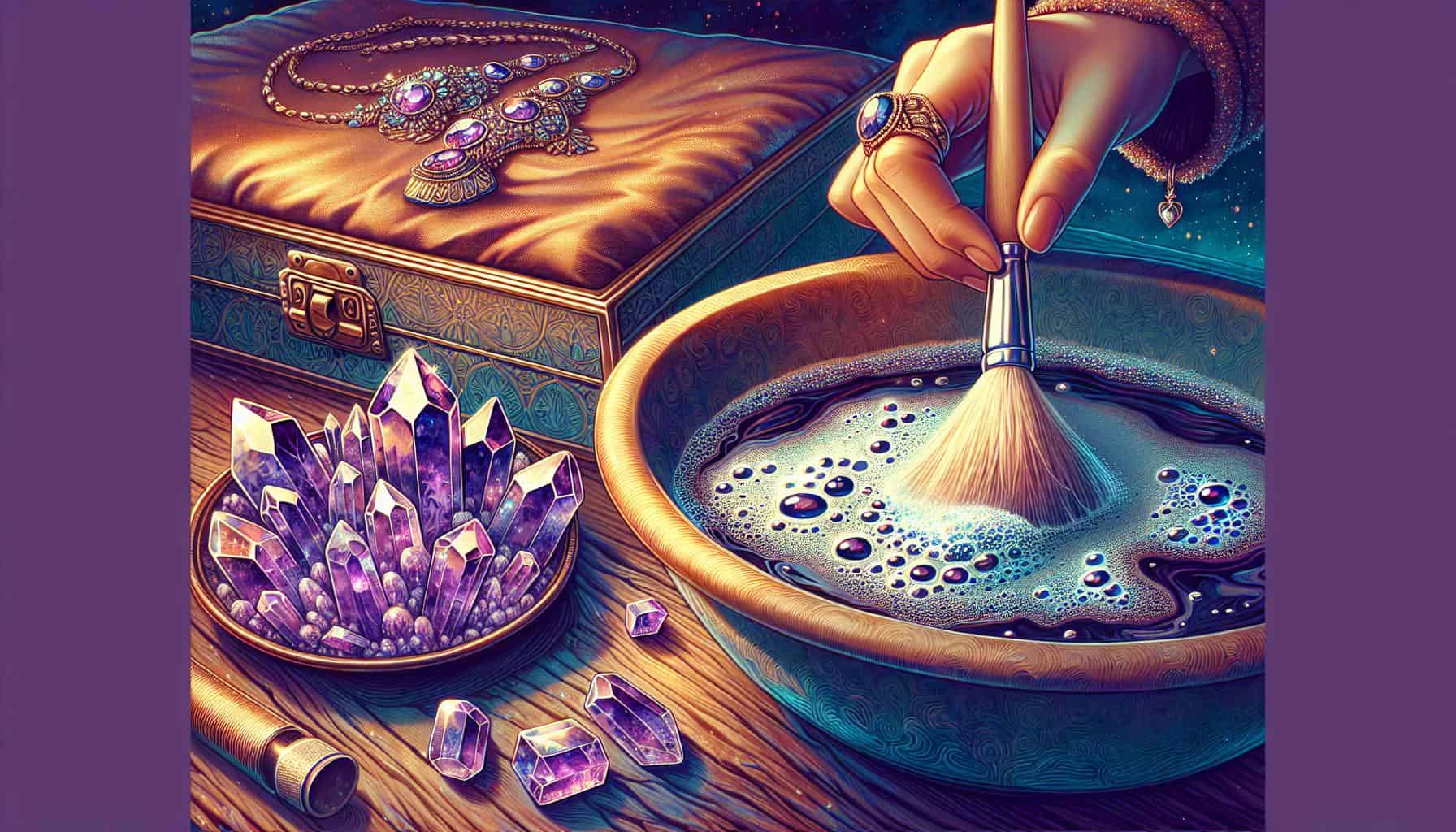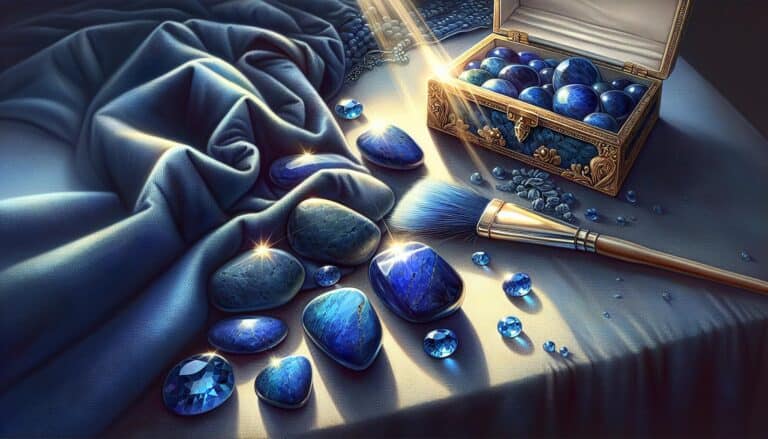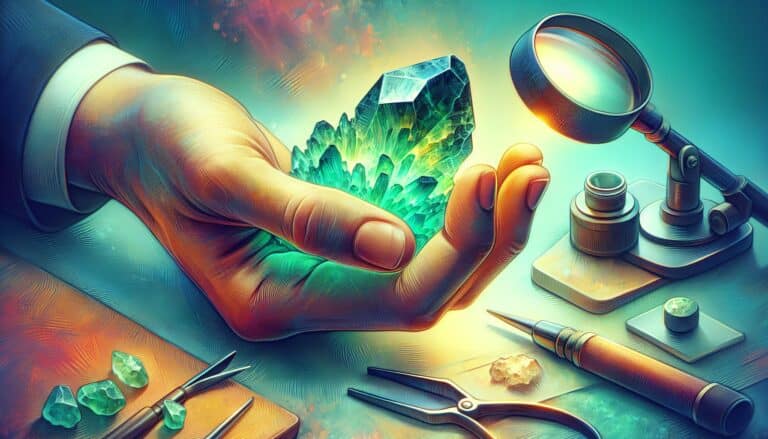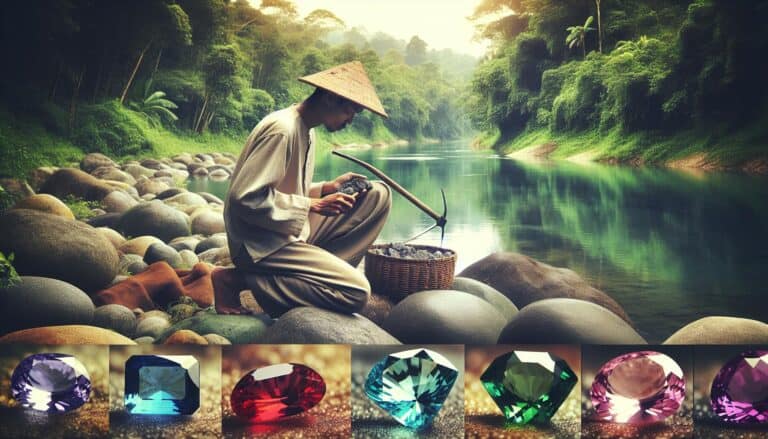Discovering the secrets of amethyst starts with knowing how to spot the real deal.
You’re about to unlock the mysteries of this captivating purple gemstone, treasured since ancient times for its beauty and purported healing properties. Whether you’re a collector, a jewelry enthusiast, or simply curious, identifying genuine amethyst is easier than you might think.
You’ll learn to distinguish authentic amethyst from imitators with a few simple tips. From its unique color to the subtle nuances that set it apart, you’re on your way to becoming an amethyst identification pro.
Let’s dive into the world of this alluring quartz and ensure that your next amethyst find is as authentic as it is enchanting.
To identify genuine amethyst, check for its characteristic deep purple color, conduct a streak test for a white mark, and ensure it’s non-magnetic. Amethyst should scratch glass, being 7 on the Mohs scale, and show single refraction with a specific gravity between 2.63 and 2.65.
How to Identify Amethyst Through Testing
As you delve deeper into the art of amethyst identification, your skills need to extend beyond just admiring their beauty. Practical testing can reveal the authenticity of amethyst, and here’s how you can conduct these tests effectively.
Visual Inspection
Start with observing your amethyst’s color. Real amethysts exhibit a deep purple hue that fades into a lighter lilac. Uneven color distribution, especially with color zoning, could indicate a genuine stone, as synthetics often have consistent coloring. Also, look for natural inclusions, which are rare in artificial counterparts.
The Streak Test
The streak test is straightforward – scrape your stone across an unglazed porcelain plate. True amethyst leaves a white streak; any other color suggests it’s not authentic. This non-destructive method provides quick insight into the mineral’s composition.
Magnet Test
Amethyst is not magnetic, so if your stone is attracted to a magnet, you’ll know it’s been mixed with other minerals or is a clever fake.
Hardness Test
Amethyst sits at 7 on the Mohs hardness scale. A simple test to check hardness is to see if the stone scratches glass or is scratched by a steel file. If your specimen is unable to scratch glass or is easily scratched by a file, it may not be a real amethyst.
Birefringence Test
This test examines the crystal structure. Place your amethyst on a dot on a piece of paper. Through birefringence, you should see two distinct dots when looking through the gem. If only a single dot is visible, the stone may not be a true amethyst.
Checking The Diaphaneity
Amethysts are translucent to transparent. When you hold the gem up to the light, you’re looking for a certain amount of light to pass through, highlighting its structure and any imperfections. High transparency often points toward a synthetic source.
Single or Double Refraction
Use a refractometer to check if your amethyst has single or double refraction – a characteristic that splits light into two rays. Amethyst should show double refraction due to its hexagonal crystal system.
Refractive Index Test
For a more precise assessment, measure the stone’s refractive index using specialized equipment. Genuine amethysts have refractive indexes between 1.54 and 1.55 which aligns with their quartz heritage.
Finding The Specific Gravity
The specific gravity of authentic amethyst lies between 2.63 and 2.65. You can measure this by weighing the stone in air and then submerged in water. This density test can be revealing, especially when comparing stones of similar size.
Identifying Amethysts in the Field
When searching for amethysts outdoors, look for telltale signs like the presence of other quartz minerals, as amethyst often forms alongside them. Amethyst typically resides in geodes or volcanic rocks.
Recognizing Potential Amethyst Rocks
Keep an eye out for rocks with a purple hue. Geodes containing amethyst crystals can often be identified by an outer husk of weathered-looking volcanic rock. When you spot these indicators, you might have stumbled upon an amethyst-rich site.
Understanding these tests puts you in a powerful position to discern real amethysts from fakes. With a bit of practice, you’ll enhance your gem-hunting expeditions, jewelry purchases, or simply enrich your knowledge of this captivating purple stone.
Physical Characteristics of Amethyst

Amethyst, a variety of quartz, boasts distinct physical characteristics that you can observe with the naked eye. Color is the most telltale feature of this gemstone. Amethyst typically displays a range from light lavender to deep violet, but it may also exhibit red or blue secondary hues. However, the intensity of the color can vary with the lighting.
Beyond color, examine the gemstone’s structure. Authentic amethyst crystals are hexagonal and often grow in a pointed, pyramidal shape. You’ll find that the crystal possesses a vitreous or glass-like luster when held against the light. In natural light, this luster contributes to the amethyst’s allure and is a key indicator of its authenticity.
Another physical characteristic is the presence of inclusions. While high-quality amethyst is generally clear, it’s not uncommon to find inclusions in natural stones. These may look like tiger stripes, feathering, or clouding within the crystal. These inclusions should not be considered flaws; they often add to the uniqueness and confirm the stone’s natural origins.
It’s also useful to gauge the gemstone’s temperature. Amethyst typically feels cool to the touch, even if held for some time. This is due to the stone’s good thermal conductivity, which differs from glass or plastic imitations.
Remember, these characteristics are often best observed under natural light and with a magnifying glass to capture the true essence of the stone. By closely examining the physical attributes of amethysts, you’ll be better equipped to determine their authenticity.
How Are Amethyst Formed?
Amethysts originate deep within the Earth, products of high-temperature water-rich fluids interacting with iron-laced rocks. These conditions occur most often around the rims of volcanic rocks. As these fluids cool, silica precipitates and, combined with iron impurities, forms quartz crystals tinged with a purple hue. The depth at which they form and temperature variations play a key role in the stone’s characteristics.
These gemstones can take millions of years to develop. The iron content and the amount of radiation they’re exposed to influence the intensity of their coloration. Traces of other minerals can also impact their appearance, sometimes leading to unique and highly prized variations.
Understanding the geological creation process of amethysts gives you deeper insight into the authenticity markers. These markers include distinctive growth patterns and gradient hues, which are indicators of their natural origin. Contrast this with synthetic or treated stones which may display even colors and lack the subtle zoning found in genuine specimens.
Recognizing natural amethyst involves looking for the evidence of their formation, such as characteristic inclusions and specific structural features. Knowing how amethysts are formed enables you to differentiate between the quirks of a natural formation and signs of artificial enhancement.
Preparation for Amethyst Hunting
Gathering the Right Tools
Embarking on an amethyst-hunting adventure requires the right set of-tools for both efficiency and safety. Essential tools for your expeditions include:
- Geologist’s hammer: This specialized hammer will help you to gently extract amethysts from surrounding rock.
- Chisels and pry bars: Suitable for releasing amethysts with minimal damage.
- Safety goggles: To protect your eyes from flying rock fragments.
- Gloves: To keep your hands safe from sharp edges and rough surfaces.
- Sturdy backpack: For carrying your tools and any discovered amethysts.
- Field guidebook: Essential for identifying potential amethyst-bearing rocks and geographic areas.
Remember to pack lightly—only take what you’ll actually use to avoid being weighed down. Moreover, familiarize yourself with your tools before the hunt to maximize your efficiency while out in the field.
Safety Considerations
Amethyst hunting can be hazardous if you’re not properly prepared. To ensure your safety while hunting for these purple gems, consider the following:
- Appropriate attire: Wear long sleeves, durable pants, and steel-toe boots to protect against cuts and bruises.
- Navigation tools: Carry a map, compass, or GPS device to avoid getting lost in remote areas.
- First-aid kit: Always have a first-aid kit on hand for minor injuries.
- Communication device: Ensure you have a way to call for help in case of an emergency, especially in areas with poor cell service.
- Tell someone: Inform a friend or family member of your hunting location and expected return time.
By implementing these safety measures, you’re not only protecting yourself but also ensuring that your hunt for amethyst is a pleasant and rewarding experience. Keep in mind that being prepared is just as much about ensuring your immediate safety as it is about safeguarding the value and condition of the amethysts you discover.
Handling and Care of Found Amethyst

Once you’ve successfully located and collected amethyst, proper handling and care become paramount. Not only do these steps preserve the natural beauty of your finds but they also ensure they remain intact for further inspection, sale, or personal use.
Cleaning Amethysts
When you’ve brought your amethysts home, the first step is to clean them. Start by gently washing the stones with warm water to remove any loose dirt and debris. Use a soft-bristled brush like a toothbrush to scrub away any clinging dirt. Avoid harsh chemicals or abrasive materials that might scratch the surface or damage the amethyst.
For more stubborn deposits, soak the stones in warm, soapy water for a few hours before scrubbing. Some enthusiasts also recommend using a mild solution of iron-out product to enhance the coloration, but you should proceed with caution and fully understand the implications for your specific stones.
Storing Amethysts
Storing your amethysts correctly is just as important as cleaning them. They should be kept in a cool, dry place out of direct sunlight which can fade their color over time. Wrap each crystal in a soft cloth or place them in a fabric-lined jewelry box to prevent them from scratching each other.
For larger specimens, you might consider bespoke display cases that both protect and showcase their unique beauty. Maintaining a consistent temperature and humidity level in the storage area helps prevent any potential damage from environmental factors.
Remember, with the proper care, your amethysts can remain as dazzling as the day you found them. Keep them clean, safely stored, and away from harsh environments to preserve their value and splendor.
Conclusion: Confirming Amethyst is Real
Now that you’ve got the know-how, confirming whether your stone is a true amethyst should be a breeze.
Remember, the key is in the details—from the color and clarity to the unique inclusions that set genuine amethysts apart. Don’t forget, the way you handle and care for your find is just as crucial. Treat it with the respect it deserves and you’ll ensure its beauty remains for years to come. Armed with these insights, you’re ready to appreciate and maintain the luster of your amethyst, whether it’s a new addition to your collection or a beloved heirloom.
Happy gem hunting!







